Quick change closing wheel assembly with centering adjustment
Sivinski Dec
U.S. patent number 10,512,207 [Application Number 15/451,736] was granted by the patent office on 2019-12-24 for quick change closing wheel assembly with centering adjustment. This patent grant is currently assigned to Harvest International , Inc.. The grantee listed for this patent is Harvest International, Inc.. Invention is credited to Jeffrey Alan Sivinski.
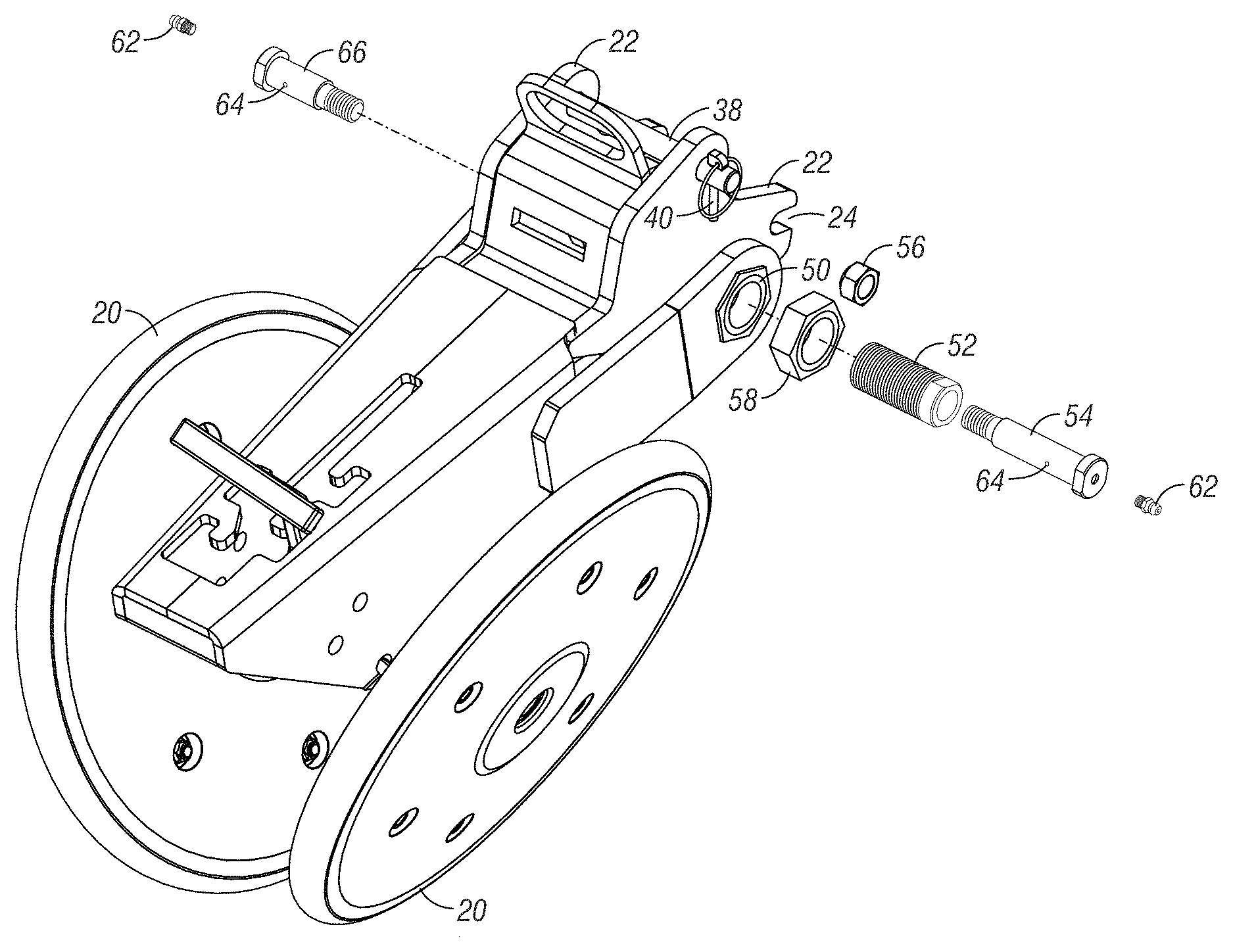



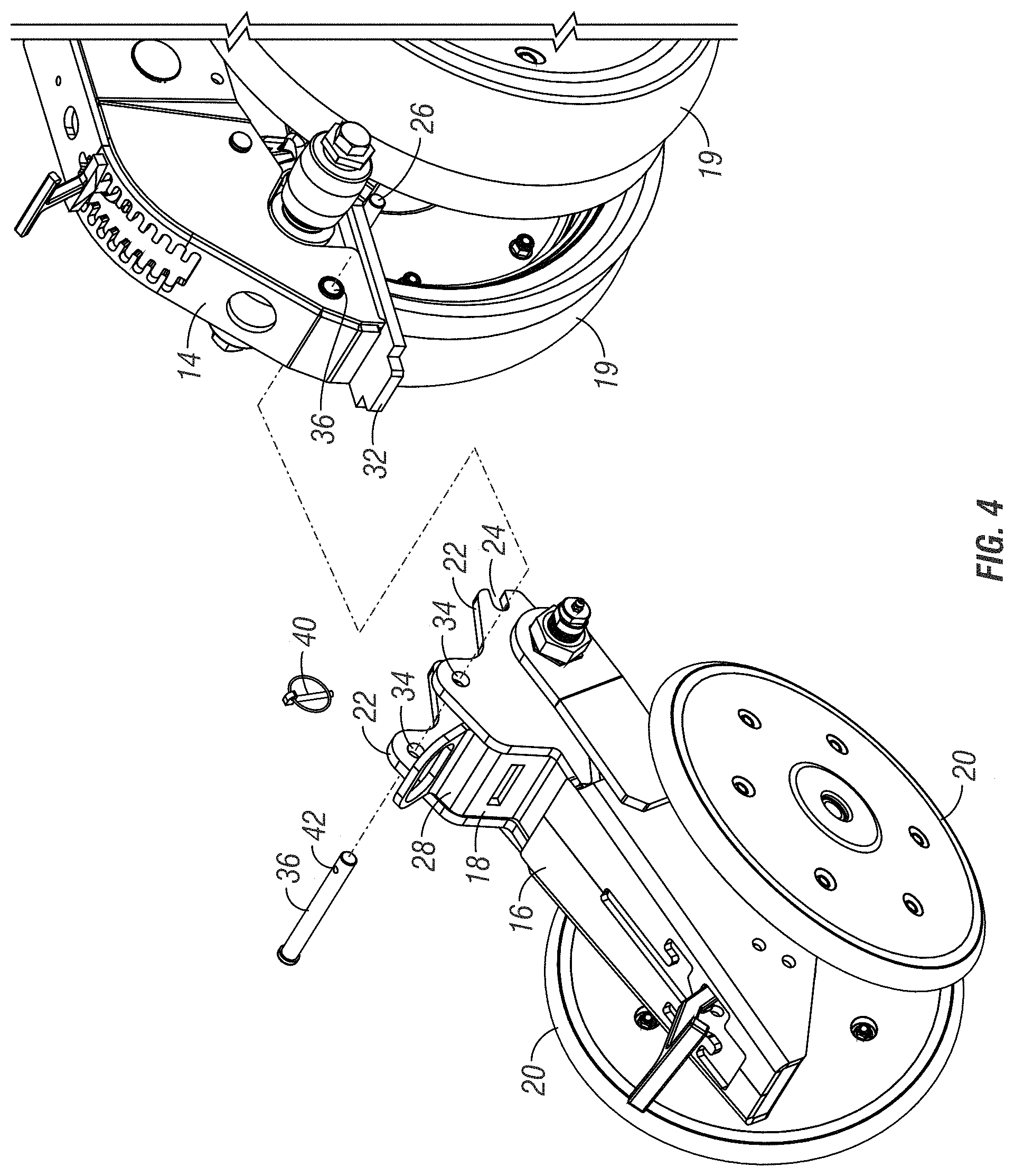
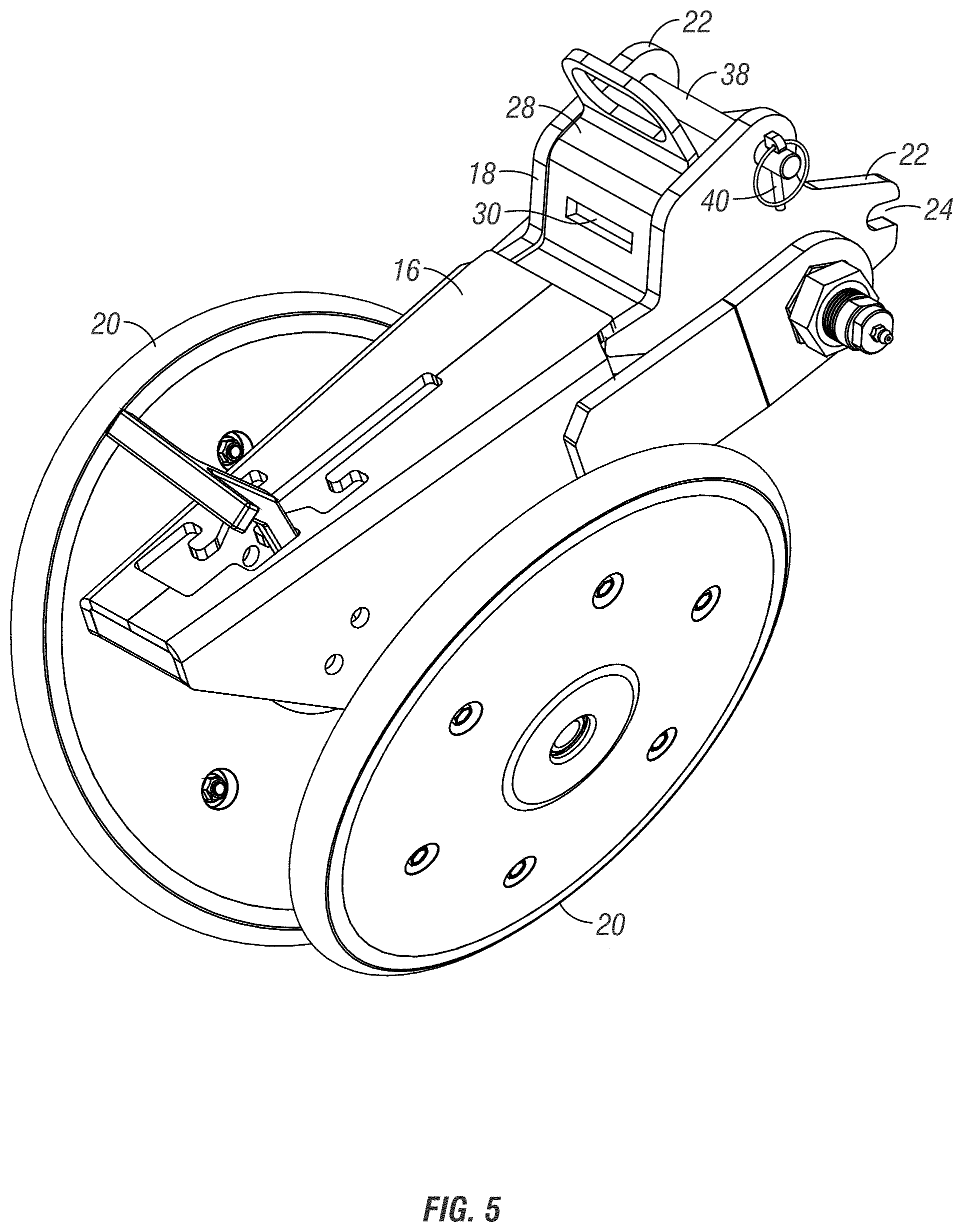

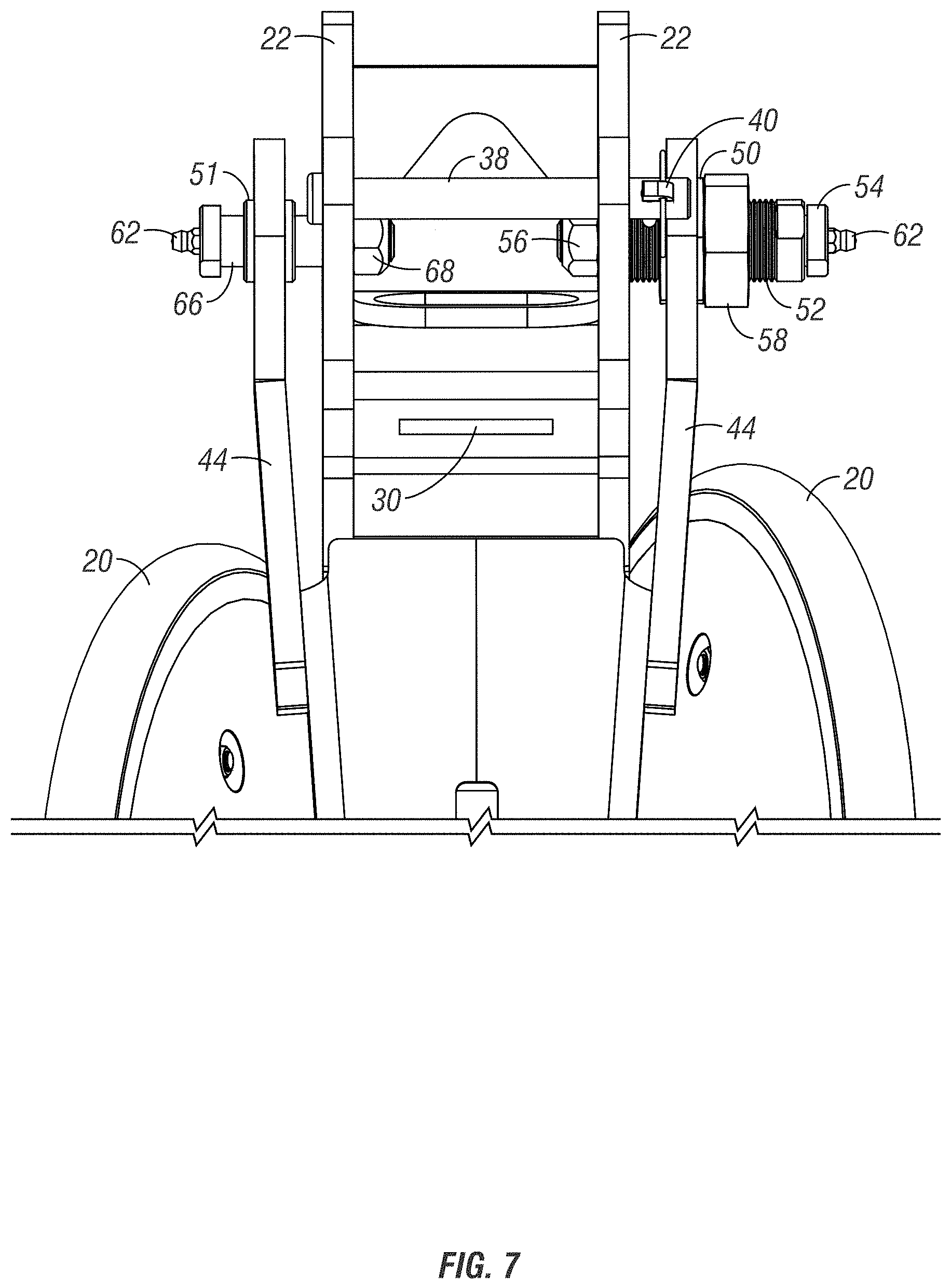

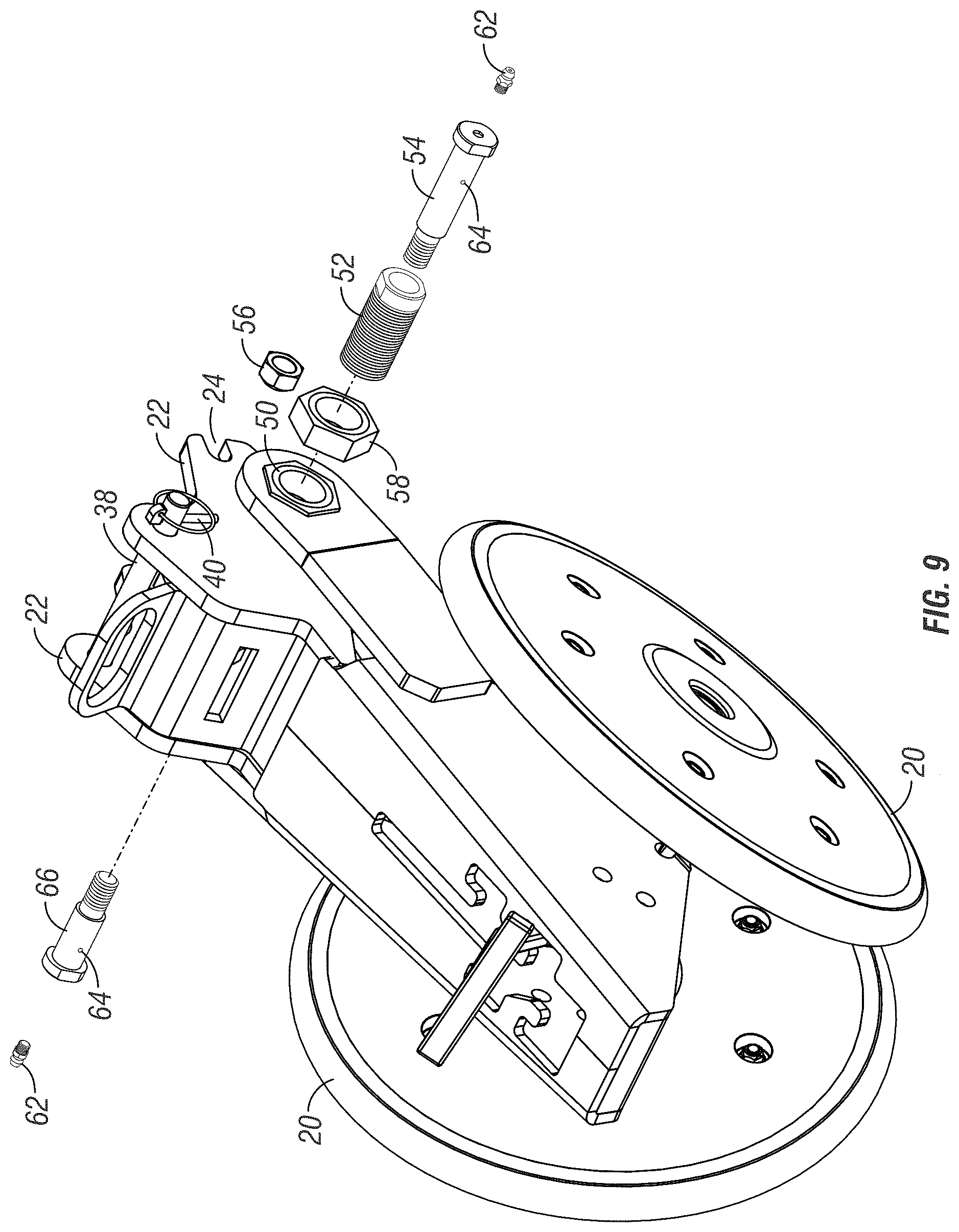
| United States Patent | 10,512,207 |
| Sivinski | December 24, 2019 |
Quick change closing wheel assembly with centering adjustment
Abstract
A closing wheel assembly is provided for a seed row planter unit behind the gauge wheel assembly and furrow disks of the planter unit. The closing wheel assembly includes a coupler with a pair of closing wheels mounted thereon. A single pin removably extends through the coupler and through the gauge wheel assembly to detachably mount the closing wheel assembly to the gauge wheel assembly. Different closing wheel assemblies can be quickly mounted on the row unit, depending upon the type of seed being planted. The closing wheels are laterally adjustable via a rotatable threaded bushing so as to be centered behind the furrow disks.
| Inventors: | Sivinski; Jeffrey Alan (Cherokee, IA) | ||||||||||
|---|---|---|---|---|---|---|---|---|---|---|---|
| Applicant: |
|
||||||||||
| Assignee: | Harvest International , Inc.
(Storm Lake, IA) |
||||||||||
| Family ID: | 58358960 | ||||||||||
| Appl. No.: | 15/451,736 | ||||||||||
| Filed: | March 7, 2017 |
Prior Publication Data
| Document Identifier | Publication Date | |
|---|---|---|
| US 20170258002 A1 | Sep 14, 2017 | |
Related U.S. Patent Documents
| Application Number | Filing Date | Patent Number | Issue Date | ||
|---|---|---|---|---|---|
| 62304984 | Mar 8, 2016 | ||||
| Current U.S. Class: | 1/1 |
| Current CPC Class: | A01C 5/068 (20130101); A01B 49/027 (20130101); A01C 7/201 (20130101); A01C 5/066 (20130101) |
| Current International Class: | A01C 5/06 (20060101); A01B 49/02 (20060101) |
| Field of Search: | ;111/193,195,196 |
References Cited [Referenced By]
U.S. Patent Documents
| 4116140 | September 1978 | Anderson et al. |
| 4307674 | December 1981 | Jennings et al. |
| 4404918 | September 1983 | Whalen et al. |
| 4570554 | February 1986 | Clark |
| 4579071 | April 1986 | Johnson |
| 4596200 | June 1986 | Gafford et al. |
| 4714033 | December 1987 | Neumeyer |
| 4920901 | May 1990 | Pounds |
| 5375542 | December 1994 | Schaffert |
| 5427038 | June 1995 | Ege |
| 5562055 | October 1996 | Petersen |
| 5676073 | October 1997 | Bergland et al. |
| 5697455 | December 1997 | Deckler |
| 5826337 | October 1998 | Klinkner et al. |
| 5896820 | April 1999 | Klinkner et al. |
| 6041584 | March 2000 | Honl |
| 6237696 | May 2001 | Mayerle |
| 6918343 | July 2005 | Kester |
| 7631607 | December 2009 | Vandersnick |
| 7669536 | March 2010 | Martin |
| 7975629 | July 2011 | Martin |
| 8267021 | September 2012 | Mariman et al. |
| 8333161 | December 2012 | Arnett et al. |
| 8393407 | March 2013 | Freed |
| 8789481 | July 2014 | Castagno Manasseri et al. |
| 8863857 | October 2014 | Bassett |
| 8939095 | January 2015 | Freed |
| 9148989 | October 2015 | Van Buskirk et al. |
| 2005/0072344 | April 2005 | Kester |
| 2011/0155031 | June 2011 | Arnett et al. |
| 2013/0160684 | June 2013 | Whalen et al. |
| 2013/0333599 | December 2013 | Bassett et al. |
| 2014/0033958 | February 2014 | Bassett |
| 2015/0000940 | January 2015 | Patwardhan et al. |
| 2015/0271986 | October 2015 | Sauder et al. |
| 2015/0359162 | December 2015 | Needham et al. |
| 2016/0050837 | February 2016 | Schaffert et al. |
Other References
|
European Patent Office, "Notification of Transmittal of the International Search Report and the Written Opinion of the International Searching Authority, or the Declaration" issued in connection to International Application No. PCT/US20177/021111, dated Aug. 22, 2017. cited by applicant. |
Primary Examiner: Will; Thomas B
Assistant Examiner: Mitchell; Joel F.
Attorney, Agent or Firm: McKee, Voorhees & Sease, PLC
Parent Case Text
CROSS-REFERENCE TO RELATED APPLICATIONS
This application claims priority to previously filed provisional application, U.S. Ser. No. 62/304,984, filed Mar. 8, 2016, which is herein incorporated by reference in its entirety.
Claims
What is claimed is:
1. A closing wheel assembly for a row planter, comprising: a frame having opposite first and second lateral sides; a pair of closing wheels rotatably mounted on the frame; a coupler for mounting the frame and closing wheels to the row planter, the coupler having opposite first and second lateral sides; and a threaded bushing extending through the first sides of the frame and coupler; an unthreaded bushing extending through the second sides of the frame and coupler; and the threaded bushing being rotatable to adjust both sides of the frame relative to the coupler so as to simultaneously move the closing wheels for lateral positioning.
2. The closing wheel assembly of claim 1 wherein the frame includes arms positioned on opposite sides of the coupler and mounted to the coupler with a pair of bolts.
3. The closing wheel assembly of claim 2 wherein one of the bolts extends through the threaded bushing.
4. The closing wheel assembly of claim 2 wherein the bolts define a pivot axis for the frame.
5. The closing wheel assembly of claim 1 wherein the frame does not pivot about a vertical axis.
6. The closing wheel assembly of claim 1 further comprising a jam nut on the threaded bushing to lock the frame in a selected lateral position.
7. A seed row planter, comprising: a mounting bracket adapted to mount the row planter to a tool bar; a first frame; a pair of furrow disks on the first frame; a pair of gauge wheels on the first frame; a second frame detachably mounted to the first frame; a first pair of closing wheels on the second frame for use with planting a first type of seed; a third frame detachably mounted to the first frame as a substitute for the second frame; a second pair of closing wheels on the third frame for use in planting a second type of seed; and the second and third frames being interchangeably mounted on the first frame using a first coupling including a single non-threaded pin removably extending through one of the second or third frames and a non-threaded retainer on the pin to prevent withdrawal of the pin and using a second coupling including laterally extending posts on the first frame and forwardly open notches on the second and third frames received on the posts.
8. The seed row planter of claim 7 wherein each of the second and third frames includes an adjustment mechanism to center the first and second pairs of closing wheels, respectively.
9. The seed row planter of claim 8 wherein the adjustment mechanism includes a threaded bushing.
10. A method of assembling furrow closing wheels onto a seed row planter unit comprising: selecting a pair of closing wheels from a first set of closing wheels and a second set of closing wheels based on the type of seed to be planted; mounting the selected pair of closing wheels onto the row planter using a single thread-free pin removably extending through a frame on the selected set and a retainer to preclude withdrawal of the pin from the frame during use of the row planter unit the selected set of closing wheels is further mounted to the row planter unit by positioning forwardly open notches on the selected set onto posts on the row planter unit.
11. The method of claim 10 further comprising centering the selected pair of closing wheels by turning a threaded bushing.
12. The method of claim 10 wherein the pin extends through a first frame supporting the pair of closing wheels and through a second frame supporting a pair of furrowing disks.
13. The method of claim 10 wherein the notches are U-shaped.
14. A closing wheel assembly for a row planter having a gauge wheel assembly, comprising: a coupler having opposite front and rear ends and opposite lateral sides with U-shaped forwardly open notches adjacent the front end adapted to receive posts on opposite sides of the gauge wheel assembly; a pair of closing wheels mounted on the coupler; a thread-free pin removably extendable through both sides of the coupler and through the gauge wheel assembly to detachably mount the closing wheels to the gauge wheel assembly; and an adjustment mechanism for laterally adjusting the closing wheels relative to the coupler.
15. The closing wheel assembly of claim 14 wherein the coupler includes a slot adapted to receive a flange on the gauge wheel assembly.
16. The closing wheel assembly of claim 14 wherein the coupler is locked to the gauge wheel assembly solely by the pin.
17. The closing wheel assembly of claim 14 wherein the adjustment mechanism includes a threaded bushing which moves the closing wheels laterally when the bushing is rotated.
Description
BACKGROUND OF THE INVENTION
Row planters with a plurality of row units are commonly used in farming to plant seeds for various crops. The row planter includes a tool bar attached to a tractor, with seed hoppers and row units mounted to the tool bar. Each row unit includes a pair of disks for forming a furrow, a pair of gauge wheels, and a pair closing wheels to close the furrow after seed has been planted. Depending upon the type of seed being planted, such as corn or soybeans, different types of closing wheels are sometimes used. However, since the closing wheels are conventionally mounted using nut and bolt fasteners, changing the closing wheels is a slow, time consuming process. Thus, there is a need for quick change closing wheel assembly for use on row planters.
The bolted coupling of the closing wheel assembly to the row planter also makes it difficult to precisely center the closing wheels, which is important for best crop yield. If the closing wheels are off-center, the soil may not sufficiently cover the planted seeds, thereby reducing crop yield. Therefore, there is a need for a closing wheel assembly which can be quickly and easily adjusted to maintain a proper centered position relative to the furrows.
Accordingly, a primary objective of the present invention is the provision of a closing wheel assembly for a row planter which can be quickly and easily attached and detached to the guide wheel assembly of the row planter.
Another objective of the present invention is a provision of interchangeable closing wheels assemblies which can be quickly and easily exchanged for one another on a row planter.
A further objective of the present invention is a provision of a closing wheel assembly for a row planter which can be quickly and easily adjusted to center the closing wheels for proper alignment on the row planter unit.
Still another objective of the present invention is the provision of a seed row planter wherein the closing wheel assembly which mounts to the guide wheel assembly using a single pin.
Yet another objective of the present invention is the provision of a closing wheel assembly for a row planter unit which can be removed and replaced with a different closing wheel assembly, depending upon the type of seed being planted.
Another objective of the present invention is the provision of closing wheel assembly for a row planter which can be centered by loosening a nut and turning a threaded bushing.
Still another objective of the present invention is the provision of a closing wheel assembly having adjustable arms for centering the closing wheels.
A further objective of the present invention is the provision of a closing wheel assembly for a seed row planter which is economical to manufacture and durable in use.
These and other objectives will become apparent from the following description of the invention.
SUMMARY OF THE INVENTION
A closing wheel assembly is provided for a seed row planter unit which is quickly and easily interchangeable with a second closing wheel assembly depending on the type of seed being planted. Each closing wheel assembly it is detachably mounted to the guide wheel assembly by a single pin extending through aligned holes in the closing wheel assembly and the guide wheel assembly.
The closing wheels of the closing wheel assembly can be laterally adjusted so as to center the wheels for accurate planting. The centering mechanism includes a pair of bolts extending through arms on opposite sides of the closing wheel assembly and which define a pivot axis for the arms. One of the bolts extends through a threaded bushing which can be turned by a wrench to adjust the lateral positions of the arms, and then locked in place by a jam nut.
BRIEF DESCRIPTION OF THE DRAWINGS
FIG. 1 is a side elevation view of the guide wheel assembly and the closing wheel assembly of a row planter unit in accordance with present invention.
FIG. 2 is a perspective view of the guide wheel and the closing wheel assemblies shown in FIG. 1.
FIG. 3 is an exploded view of the guide wheel assembly and the closing wheel assembly with the quick coupler pin, according to the present invention.
FIG. 4 is another exploded perspective view of the guide wheel assembly, the closing wheel assembly, and the quick coupling pin.
FIG. 5 is a perspective view of the closing wheel assembly having the centering adjustment mechanism according to the present invention.
FIG. 6 is a perspective view from the front end of the closing wheel assembly having the centering adjustment mechanism according to the present invention.
FIG. 7 is a top plan view of the closing wheel assembly and showing the quick coupler pin and self-centering mechanism, according to the present invention.
FIG. 8 is a front elevation view of the closing wheel assembly with the quick coupler pin and the centering adjustment mechanism.
FIG. 9 is an exploded perspective view showing the centering adjustment mechanism, according to the present invention.
DESCRIPTION OF THE DRAWINGS
A row unit 10 for an agricultural row planter is shown in FIG. 1. The row unit 10 includes a mounting bracket 12 to attach the row unit 10 to a tool bar (not shown) hitched to a tractor, a first frame 14 mounted on the bracket 12, and second frame 16 detachably connected the first frame 12 by a coupler 18. The first frame supports a pair of disks 17 which form a furrow, and a pair of gauge wheels 19. The second frame 16 supports a pair of closing wheels 20.
The present invention is directed towards improvements to the closing wheel assembly 16, 18, 20 which allows one set of closing wheels to be quickly and easily interchanged with a second set of closing wheels, and which allows for simple lateral adjustment to center the closing wheels behind the disks 17.
More particularly, the coupler 18 allows a farmer to interchange different closing wheel assemblies depending on what seed is being planted. The coupler 18 includes side plates 22, each of which have a notch 24 at the forward end. Each notch 24 is adapted to receive a stud post 26 extending laterally outwardly on opposite sides of the gauge wheel frame 14.
The coupler 18 also includes a central web 28 extending between the plates 22 with a slot 30 formed in the web 28. The slot 30 is adapted to receive a tab 32 extending rearwardly from the gauge wheel frame 14.
Each of the side plates 22 of the coupler 18 have a hole 34 which aligns with a hole 36 extending through the gauge wheel frame 14. A retaining pin 38 is removably inserted through the holes 34, 36 to connect the coupler 18 to the frame 14. A lynch pin or cotter pin 40 extends through a hole 42 in the retaining pin 38 to prevent the retaining pin from accidentally being withdrawn or falling out.
After one closing wheel assembly is removed from the gauge wheel assembly a different closing wheel assembly can be quickly mounted to the gauge wheel assembly by positioning the notches 24 of the side plates 22 onto the posts 26 of the gauge wheel frame, 14 with the tab 32 of the gauge wheel frame 14 extending through the slot 30 in the closing wheel coupler 18, then inserting the pin 38 through the aligned holes 34, 36, and securing the pin 38 with the pin 40.
Thus, the different sets of closing wheel assemblies can be quickly and easily interchanged simply by removing the pin 38 and disengaging the closing wheel assembly from the gauge wheel frame 14. This process saves significant time, compared to unbolting the closing wheels 20 from the frame 16 and substituting different closing wheels.
After the closing wheel assembly is attached to the gauge wheel frame, the closing wheels 20 can be centered for proper alignment behind the disks 17. The closing wheel frame 16 includes spaced apart arms 44 which extend along opposite sides of the coupler 18. The arms 44 each have a hole 46 therein, which aligns with a hole 48 in each of the side plates 22 of the coupler 18. One arm has a threaded nut 50 welded or otherwise fixed in or over the hole 46, while the other arm has a bushing 51 pressed or mounted in the hole 46.
On the right arm 44, a threaded adjustment bushing 52 extends into the nut 50. A pivot bolt 54 extends through the bushing 52 and is secured by a nut 56 on the inside of the right-side plate 22. The bushing 52 has opposite flattened surfaces 53 to receive the head of wrench or pliers, so as to turn the bushing for adjustment. A jam nut 58 is also provided on the bushing 52, to lock the bushing against rotation when the nut 58 is tightened. The bolt 54 has an axial channel 60 extending from the bolt head, with a grease zerk 62 mounted in the head. A grease outlet 64 allows grease to flow between the bolt 54 and the inside wall of the bushing 52.
On the left side, a pivot bolt 66 extends through the bushing 51 in the hole 46 and through the hole 48, and is secured by a nut 68 on the inside of the left plate 22 of the coupler 18. The bolt 66 is similar to the bolt 54, with an axial channel, a grease zerk 62, and a grease outlet 64 for greasing the inside of the bushing 51.
To center the closing wheels 20 relative to the disks 17, the jam nut 58 is loosened on the adjustable bushing 52, and the bushing is turned with a wrench into and out of the nut 50, such that the arms 44 can slide laterally left and right on the bolts 54, 66 so that the frame 16 is in a desired position. Then, the jam nut 58 can be tightened on the bushing 52 to prevent further lateral movement of the frame 16.
Thus, the bushing 52 and bolts 54, 66 provide an adjustment mechanism to allow quick and easy centering of the closing wheels 20. The bolts 54, 66 also allow the closing wheel frame 16 to pivot about the horizontal axis of the bolts as the row planter moves through the field. Thus, the bolts define an axle for pivotal movement of the closing wheel frame.
The invention has been shown and described above with the preferred embodiments, and it is understood that many modifications, substitutions, and additions may be made which are within the intended spirit and scope of the invention. From the foregoing, it can be seen that the present invention accomplishes at least all of its stated objectives.
* * * * *
D00000

D00001

D00002

D00003

D00004

D00005

D00006

D00007

D00008

D00009

XML
uspto.report is an independent third-party trademark research tool that is not affiliated, endorsed, or sponsored by the United States Patent and Trademark Office (USPTO) or any other governmental organization. The information provided by uspto.report is based on publicly available data at the time of writing and is intended for informational purposes only.
While we strive to provide accurate and up-to-date information, we do not guarantee the accuracy, completeness, reliability, or suitability of the information displayed on this site. The use of this site is at your own risk. Any reliance you place on such information is therefore strictly at your own risk.
All official trademark data, including owner information, should be verified by visiting the official USPTO website at www.uspto.gov. This site is not intended to replace professional legal advice and should not be used as a substitute for consulting with a legal professional who is knowledgeable about trademark law.